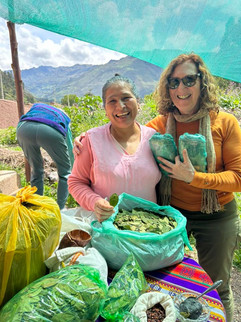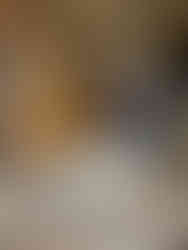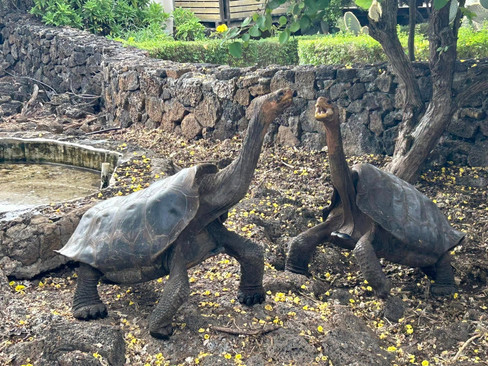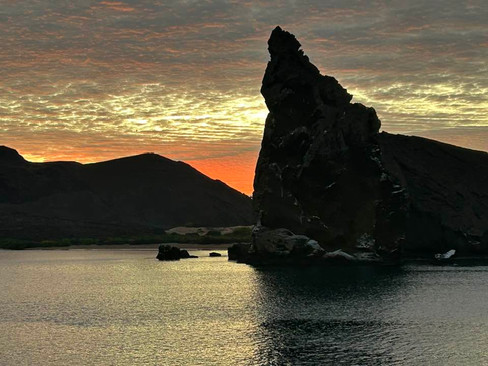My Trip to Peru and the Galapagos Islands
- susanschlank
- Dec 17, 2023
- 22 min read
Day #1
Urubamba
I had a bit of a glitch on my way here. I had a 6:00am flight. I got to the airport at 4:00 but still missed my flight. The good news- Jeff picked me up and I spent the day with the girls. I got a flight at 5:00 pm and arrived in Peru at 6:30 am without my checked bag. I think it’s still in Miami. Hopefully they’ll get it to me tomorrow.
I walked and shopped all day today! A city right on the water. Some beautiful murals. I love love the statue!
There was a lot of violence in Peru in the late 70s, 80s and 90s . They call it terrrorism , but it was internal. The Peruvians with extreme communist and socialism ideologies from the countryside tried to run elections. When that didn’t work they became more radical. A professor named Abimael Guzman led the movement of the Shining Path, the Peruvian Communist party. He was a professor and the leader of this movement. He began sharing his ideas that were a combination of Communism, Socialism, and his own vision. Many of the Communist countries gave him support. This was a period of terror. They executed people who didn’t agree with him. In 1992 they attacked this particular street because there was a wall. They put dynamite on a car. In this incident 20 people were killed. The police were unable to control the violence so the army was called in. Because it was so hard to identify who was a terrorist and who was not, many innocent people were killed in the cross fire. Over 79,000 people were killed. Most of the victims were fleeing the countryside.There is a monument on the street to remember those people killed on this street. This is called the terrorist time. The leader was captured and imprisoned. The president Kujumoro was imprisoned for corruption. He was granted a presidential pardon but it was denied by the Supreme Court. When Kujumro died in prison there was controversy about whether he should be buried in Peru. They didn’t want him to be memorialized. In the end he was buried in Peru but blocked from people.

The government of Peru is set up with the Federal government, then the state government, then the provinces, then the districts. Lima has 43 districts with 43 mayors.
We went to Museo De Sitio Huaca Pucllana which translates to “a place to play”.The Peruvians named it that. This area represents 3 cultures. First the Lima culture, 200 years after Christ, the Wari 650 d.c. and the ychsman 1450 d.c. Most of the pyramids built by the Lima culture were destroyed. There were more than 24 culture in Lima before the Inca. In the Lima culture they worshiped the shark, the divinity of the sea, and the moon. It was a matriarchal culture, but women, ages 12-25, were sacrificed because they represented fertility. The temples were made of adobe bricks that were hand made. A mixture with sea shells was used as the glue. The bricks were laid like a bookshelf pattern with spaces in between for flexibility. The holes in the ground is where people gave gift to the gods. Every time a new priest was elected he covered up the old temple and built on top of it, so no one knows exactly how many layers there are. After the Limas came the Wari or Ishmas . They used the site as a cemetery. You could see the mummies of two adults and a 5 month old baby that was sacrificed and used as a guide into the afterlife. Sort of a “tour guide”. The Ishmas covered the site. Before 1981 the area was owned by a contracting company. People played football and threw garbage on it. In 1981 it began to be excavated. There are 6 acres that are now protected. It will take another 40 years to finish excavating it. Originally there were about 12 acres. (I find the picture with the old and the new juxtaposed interesting)
(A whole park for cats and it didn’t smell)

Day #2
Lima
A third of the population of Peru lives in Lima. As of the last census 33 million people live in the entire country , but that census was taken in 2016 and was inaccurate even then. Despite Peru being a melting pot of cultures and different nationalities there is still discrimination. A man was denied service in a restaurant because “He looked untrustworthy.” After that the government said that anyone who denies service on the basis of appearance will have their business shut down.
In Peru there are 28 out of 32 different weather patterns.
Today we went to the fish market. Peru has 1070 different kinds of fish and shellfish. Sea bass and flounder are common. The fishermen are self-employed and there is no back up system or government assistance. They go out fishing between 10-11 p.m. and come back between 4:00 and 5:00 a.m. This is when the restaurants come to buy for the day. When the navy says it’s too dangerous to go out they have to stay in. That’s when they do the maintenance of the nets. The sea lions tear them. El Niño makes the temperature rise so the fish go deeper. The last time this happened was in 2017. Before that it was 30 years before. This makes it much harder to fish. It is happening now so many of the vendors were not there. Fish is expensive so not all Peruvians can afford it. No one gets assistance from the government unless they are in extreme poverty- starving, homeless. When the fishermen can’t go out they look for other work.
We were treated to some ceviche and watched the chef make it. If you want the recipe, I know the ingredients. We also had some Inca Cola. It tasted like cream soda. I actually liked it.
Health care system- If you do not have insurance through your employer you have to pay for insurance or pay directly for care. Voting is mandatory. If you don’t vote you have to pay. Interesting….. That would get greater voter turnout. Eighty percent of the schools in Lima are private.
We went to the Museo Larco. Raphael Hoyle started to collect artifacts from his own excavations and then he began buying them from families. He amassed the largest collection of architectural pieces in the world. Most of the pieces were pots used for ceremonial drinks . Most of the artifacts were found in the tombs, therefore they were well preserved. They were buried as offerings to the gods with the people. Hundreds of them were buried in one tomb. It was an Animist religion. They worshiped nature. Rain was the most important element since this area of Peru is a dessert. Birds such as the eagle or condors represented the heavens, then humans, and snakes the underworld. Totems changed according to where you lived. Some of the vessels had strange eyes. It can be assumed they were on hallucinogens. In the southern region the pots were more colorful because there were more minerals in the soil. This was done by the Huari or Wari culture. This is the culture that started the Inca trail. The Largo family still owns the museum and all the pieces. They are the riches family in Peru.
There was also a collection of metal works. Most of it was mixed with silver. We also saw a mummy of a child who was entombed in a fetal position within a vessel. There were skulls with holes in them showing that they attempted surgery back then and sometimes the person lived. There was a collection of earrings, big round objects that the men wore , sometimes bringing their earlobes to their shoulders. There are 400 archeological sites in Lima!
Next we saw the historical center of Lima. Most of the streets have been made pedestrian only. We saw the presidential palace where the president conducts business and many other buildings.

Day #3
Cuzco
Lima is the second largest city in a dessert. The Amazon River does not go to the Pacific. It goes to the Atlantic. All the mountains used to be under water. Due to the movement of the tectonic plates they were pushed up. When this happened some dolphins got trapped in the river and were unable to get back to the ocean. They adapted to their new environment and became pink. The Amazon Basin is the only place in the world with pink dolphins.
Cultures have been discovered that are 5000 years old. In these civilizations they had aqueducts, temples and houses. There is evidence that they used engineering and astronomy. There are three official languages in Peru. However, if a person speaks a dialect such as Imara in the highlands they may find discrimination. There were many cultures before the Incas but the Incas had such rapid expansion that they became very well known. When the Spanish came in they destroyed relics. Manchu Picchu is one of the few that was not destroyed. Independence was fought by the dependents of the Spanish, comparable to the independence fought by the U.S. from Britain.
Voting is mandatory. If you do not vote you will have to pay a fine and will be unable to do any official business until it is paid. The downside: people who are uninformed vote and someone could become president with less than 10% of the vote. There could be many candidates to start and then the top two are voted on. The minimum wage is 1200 sole a month equivalent to $350-$370. This is for worker like teenagers. People with more experience get more. Eighty eight percent of Peruvians are Roman Catholic and it has to be taught in the public schools.
Mining is the main economy. They have gold, copper, silver, uranium, etc. Although they have minerals they do not have any manufacturing so minerals go out and then Peruvians have to buy products back. 60% of the people work in the underground economy, meaning they are independent and if they say they earn less than $25,000 they don’t have to pay taxes. 30% of people work for some form of the government. There is a high sales tax ,18% ,since they don’t get a lot of taxes from the people, most of whom are evading paying taxes. Controversially they are starting to ask for IDs when you buy things so the government can track if you are spending more than you are reporting.
We took a plane from Lima to Cuzco. And then continued driving through the Andes Mountains and saw the Sacred Valley. The definition of “awe”. It is so beautiful and you can feel the power of the site.

We went to an alpaca farm where they still make textiles by hand. We had a demonstration of how they are made.
1. They get the fiber from the animal by sheering it.
2. They wash it with hot water and scrub it with a root that actually bubbles up - it is like a
natural soap.
3. Dry the threads
4. They make the threads with a pushka, like a hanging stool. Children help with this step.
5. They dye the threads . This was fascinating. They use flowers, leaves, and bugs and are
able to come up with a vast array of colors. The bugs are taken off the cactus plant. I am including a picture of the bugs. They can produce a variety of shades of red when they are squished. This is due to the minerals in their system. Adding other substances changes the color. Lemon juice makes it orange salt makes it yellow.
Color from the bugs Dying the threads
6. They double the threads to make it stronger.
7. Weaving on a loom. They do to have a pattern and they could be 1000 threads.
This collective supports 150 families in the local area. I supported the local economy for sure!!

We have arrived in our “hotel”. Which is so charming in the Urubamba Village.

Day #4
Urubamba
Health system of Peru: As I said earlier you do need to pay for most health care, but there are public hospitals. In the countryside they were built during Fujimoto’s presidency in the 1990s. So since schools and hospitals were built during his time many think he was a great president. However, he got the money to do these things through selling his country. He sold the mines to foreign investors. So for the future of Peru’s economy it has not been good. If you are following along you remember he left the country but when he came back he was arrested for corruption. At the time Fujimoto was touted for his successful birth control program. It turns out more than 300,000 women in the countryside with 6 children or more and under 35 were sterilized without their permission. Most of these women were illiterate and were tricked into coming to the hospital with offers of food supplies etc. Many people say he was a dictator.
You can get birth control through the public hospital and men over 35 can get a vasectomy for free and even get a bonus.
We met a women who grows and smuggles coca leaves. The leaves are legal in Peru and are used in many ceremonies. The leaves themselves have a lot of healing power and is sort of like coffee in terms of a “vice”. People chew it for energy as it has caffeine in it. It also has a lot of antioxidants, etc. What cocaine is made out of is just a tiny portion of the leaf that has been extracted and other compounds added. The government has been encouraged to crack down on the production of coco leaves, but since they have implemented their program production has actually gone up by 40%. The coca farmers themselves are dirt poor just trying to eek out a living. The woman we met has a small house where she lives in Urubamba and distributes the coca leaves from there. Her husband is up in the countryside growing the crops. The land was given to their families in the late 60s when the Maoist model gave the land to the people who worked it. This too has not been good for Peru’s economy in the long term. They make much more $ smuggling the coca leaves than selling it to the government. Once you get over the mountains it is easy to do it. They pack it in tight bundles and put it under their clothes and aprons with pockets. Authorities are not allowed to search women, so this is primarily done by women. If they find it, it is just confiscated - no fines or arrests. Ten percent of the yield is used in the country and 90% is exported. It takes one ton of coca to make 1 kilogram of cocaine worth about $1000 U.S. dollars. The drug dealers in Europe or Australia are the ones making $. This woman just wanted her children to be able to go to school and not have to walk hours each way. She was able to make enough to build a small house.
We went to a school. The children were so excited to have us come. They ran to meet us at the bus and each on held one of our hands. They sang us a song. This is a school that is supported by the Grand Circle Foundation. Most of the students come from very poor families and spoke only their native language before they came to school and learned Spanish. They were so excited to show us their books. We brought a treat for them, pantaloni cake, which is a tradition for Christmas. They were so excited!
We went to a home hosted dinner and helped make the chilies. They had carrots, garlic onions, peanuts, raisins, hard boiled eggs, and peas in them. They were delicious! We had roasted guinea pig, which is a delicacy and a huge offering to us. We also had potato, rice, some sort of sauce and squash soup which was delicious.
The soup recipe:
In a empty pot put in chopped onions and garlic- toast them with oil and salt. Add water. Add the pumpkin in cubes, add celery, carrots, in the pot and boil it again. Add potato and fava beans at the end. When the potatoes are cooked the soup is ready. At the very end you add spices and fresh herbs- cilantro, oregano, black pepper and salt to taste.
A group of us went on a hike in the afternoon and saw some ruins up the mountains.
We ended the day with a dinner of roasted chicken and fresh fried potatoes at the home of Oscar. I loved the chicken! Oscar is retired and used to have a rotisserie chicken restaurant. He has agreed to have OATs groups to his home. His home was amazing. It was decorated impeccably and he had art work and valuable artifacts displayed so perfectly that it looked like he made his home to accommodate them.
See pictures.
Tomorrow- off the Machu Picchu
Day #5
Machu Picchu
This morning we participated in a blessing ceremony with a shaman. Apu is the spirit of power of the mountains. The shaman did a blessing expressing gratitude and asking for protection in out travels. Patamama is Mother Earth. Being a shaman is a calling- it may come through a dream. They can choose to accept the call or not. This is not a paid job. They will be called on to conduct blessings for many occasions. He set up a beautiful alter (see picture). We each received 3 coca leaves and placed them around the objects after blowing our intention into them. He then wrapped it all up and blessed each of us and we blew back into the offering. He will take it back and burn it. They believe in the continuation of life, not reincarnation. This is why bodies were preserved in the fetal position as mummies.

Machu Picchu: All the structures were made of stone, which was slightly angled so it would not be destroyed in an earthquake. They had thatched roofs made of wood. The stone is still there but the roofs are not. There were four different kinds of structures depending on the importance of it’s use. The temples were the most precise. There were cemeteries found with the mummies wrapped in the fetal position.
We traveled by train and bus to Machu Picchu. This was another awe inspiring sight! To see the extent of the ancient city in the middle of the mountains was beyond amazing! The Inca Empire lasted from 1438 to 1533. Machu Picchu was inhabited only by the ruling upper class. About 600 people lived there. The rulers were on one side and the students, those destined to become rulers, were on the other. The city was made out of granite rocks and they used tools also made of granite to carve. The site was chosen for it’s sacred location. It is in the center of 4 sacred mountains. The Urubamba River goes like a horseshoe around it. At the solstice the sun comes up right between the mountains. On May 2 you can see the Milky Way as a perfect rainbow. There is so much evidence of their knowledge of astronomy . They had a sundial which worked as their calendar and reflecting mirror pools where they could comfortably watch the stars. (See pictures). You can see the reverence toward the mountains and nature in so much of the construction. Often the structures they made directly reflected the mountain behind it or a condor may be represented with rocks. Every wall is leaning slightly to better withstand earthquakes or tremors. There is evidence that soil was brought from sacred Valley which was at least 18 miles away. Supplies were carried by people.
All windows and doors are on an Tombs Inca bridge messengers used
angle for stability when tremors
(earthquakes) happen
Reflecting mirrors- can see the sky at night Sundial- calendar
They did not use slaves. The citizens of the Inca empire were required to work every year for maybe 1-3 months building temples and roads. This was their tax. In exchange they were given land. Twenty thousand people a day helped build the site. This went on for years. With rotating peasants paying their “taxes”. At least 20-30 thousand people worked every day. At night they had to walk hours back to their homes in the mountains. The Incas cared for their people by having store houses of food and no slaves. On the other hand, no one from a lower class could rule. The upper class made themselves look different. They wore gold and silver and big earrings, sometimes their earlobes went down to their shoulders. When they were babies they used wood on the side of their heads and wrapped them like tamales. They ended up with cone shaped heads further distinguishing themselves as rulers.
Tupac INKA Yupanqui wet sailing with 200 rafts looking for the gods. He did not find what he was looking for but reached Easter Island and brought back white sand that was used in the temples. Machu Picchu means old mountain. As opposed to new mountain, which is the pointy one in most of the pictures.
The North and the South had been fighting for about 5 years before the Spanish arrived and small pox which came in from Equador (not the Spanish-as often thought). By the time the Spanish arrived the king of the north had won. But the Spanish executed him. They opened Cuzco and put a puppet king under the Spanish rule. In 1556 he escaped and organized an army. He moved to Bilcabomba. This was the last placed that the Incas fought against the Spanish. In 1572 the Spanish destroyed the city and forgot where it had been. Until the 1900’s this was called the lost city.
Hiram Bingham, a professor from Yale went looking for the “lost city”. ( The real “lost city” was found in 1960 about 60 miles away, but it had been destroyed by the Spaniards.) Machu Picchu was never found by the Spaniards. When he got home and looked at his pictures he thought he had found it. He had not found the lost city, but he did find Machu Picchu. It was so covered with vegetation that he hadn’t realized it at the time. This was July 24, 1911. He got money from Yale, National Geographic, and the wealthy Tiffany family he had married into and started clearing the site. Two local families were living on the site when it was found. They had escaped from a plantation on the other side of the mountain. Since the Spaniards did not know about Machu Picchu it had not been destroyed. The Spaniards were looking for gold and silver, which the Incas did not consider valuable. In order to protect the city, which was valuable, they brought the gold and silver to Cuzco. There is not evidence that the Spaniards ever knew Machu Picchu was even there. Fourty percent of Machu Picchu is still covered by vegetation. As amazing and extensive it is, this is not all of it.
Day #6
Cuzco
On our way back to Cuzco we stopped at the massive Inca fortress of Ollantaytambo. This is one of the few places that the Spanish lost a battle in 1536. We climbed 293 steps to get to the top. At the top you could see the temple that was still under construction. Again, it is awe inspiring how precise and patterned the stones are. Again a connection to the spiritual world and the cycles of nature. Rocks were transported all the way across the valley. None of the rocks for this structure originated here. They were all carried in. The rocks are beveled and put together sort of like legos. This was very purposeful and followed specific plans. Again hundreds of thousands of people helped with the construction. It is believed they had a rope system and ramps with logs. The storehouses were up a different mountain. They were higher to allow for more ventilation and less insects. They used mint and coca leaves to keep away the insects.
I had seen a ring I had loved in Lima. My trip leader Ciro, suggested I get it made in Cuzco by the the best artisans he knew and the stone would come right from that area. So we had sent in pictures and worked with the artisans along the way picking out the stone etc. Today was the great reveal. It is gorgeous! I love it. It is 18 carrot gold with an Andean opal. The factory and showroom where we went showed us how they make the jewelry and then took us to their showroom. They had beautiful jewelry, mostly silver. My whole group was there for the great reveal and most of them bought jewelry as well.

We had hot chocolate and panettone, a cake with fruit, both of which are a Christmas tradition In Peru. Christmas is celebrated at midnight with a big family dinner and midnight mass. Ciro’s family joined us in the hotel. His son played the violin and his daughter played the piano. He has a beautiful family! We all went out for Peruvian burgers and onion rings. Yum!
Galapagos Islands
Ecuador -Galapagos Islands
Galapagos National Park was created in 1959 and the Galapagos Marine Reserve was created in 1998. Ninety seven percent of the Galápagos Islands is a National Park. This was done in order to avoid the invasion of new species by tourists. Our guide, Beto, is grateful for tourists because the money we pay at the airport to get into the Galapagos goes directly toward conservation. They lead the world in conservation and clean energy. Even the airport is made of recycled materials. The Galápagos Islands are oceanic Islands. They were formed by intense heat under the ocean in a volcano. Under the water the volcano is 3 times bigger than what is above the water. At the beginning, when the islands are first formed, there is no life, just black lava. Four million years ago animals began to arrive by either birds or floating on things like logs. There are 4 stages 1. Arrival 2. Establish 3. Adapt 4. Evolve-in this phase they become different from their ancestors. The biodiversity in the Galápagos Islands is very low because of this need to arrive. (As opposed to the Amazon which has 100s of species.) Although the diversity is low endemism is high. This means animals and plants have adapted differently from their ancestors and are only found here. The way species need to arrive creates lots of gaps. There are no vultures, no mammals, no amphibians. This means the animals adapt to their environment. For example, since there are no woodpeckers, finches took sticks and began to get bugs with a stick from the trees. Reptiles were able to survive since they are covered with scales and can survive without water and food for a while. This is why there is a predominance of reptiles. They arrived floating on something like a log.
The tortoises are the base of the ecosystem on the islands. Without them everything would collapse. At one point people were killing them and eating them etc. 300- 400 thousand tortoises were taken. This is now against the law and you can go to jail for killing a turtle. The National Park Service has made preserving the turtles a priority. They set up the National Park where they help the turtles to reproduce and survive before bringing them back to the island where they came from. We saw all the babies. At 5 years old they are released.
Saddleback Tortoise Tortoise
We also saw “Lonesome George”, from the Pinta Island. He was preserved behind glass. He was a male and they were unable to preserve his species, which is now extinct. The turtles grow really big because they do not have any predators, no competitors and they eat the grass. can live to 110 years old. The record is between 170-180. It takes them 25 years to reach sexual maturity. The males are generally bigger and have bigger tails. They have a two penises organ. The females lay eggs in the dry zone. They lay about 1-2 dozen eggs. It takes 120 days of gestation. No parental care is provided. The babies will walk little by little. They are herbivores in the Galapagos. The saddleback turtles eat higher vegetation so they need longer necks and longer legs.

Most animals need to find a way to eat cactus as that is all that is available. Since reptiles need only female so reproduce, they can wait for food. Female turtles can make eggs even without a male.
Most plants come by the currents or the winds. There are giant dandelion plants that came by the wind blowing it 600 miles from the mainland. Sixty percent of plants are transported by birds either by their poop of feathers.
Darwin came to the Galápagos Islands in 1835 when he was 23 years old. His theory of evolution:
1. Life forms will produce descendants similar to themselves.
2. Life produces an excessive amount of offspring.
3. No offspring is alike- genetic mutation.
4. Some reproduce better than others. The successful ones pass traits onto the next generation.
There are three eras of the islands
1. Before inhabitants
2. Colonization
3. Conservation-tourism and National Park.
IN 1930 it became a protected area. In 1959 it became a National Park, the first in Ecuador. From 1959-1969 scientists came and applied conservation techniques. You can see different vegetation and wildlife on different islands. The newest islands are the most barren with black lava covering them. As the islands get older more and more vegetation grows.
We went to a coffee farm. Farming is difficult because the soil is very shallow due to the newness of the islands. This makes it difficult to farm. Another problem is feral animals cats, dogs and goats that were brought by people.
Facts about animals:
Frigatebirds- These birds are kleptoparasites. steal food from other animals. They can not land in the water or dive. They steal food from other birds. They stay with their mothers for 12 months and learn to be independent. They have one baby. They have a huge wing span which is great for flying and can even sleep in the air. One went 18 days without flapping. They eat flying fish and take food from the mouths of other birds. I’m sure they were hanging around our boat at sunrise hope to find some food to steal.

Blue-footed boobies-They got their name from the Spanish word “bobo” meaning “clown”. I think these are adorable! They have blue feet as a result of their diet and refraction of light. The males dance to attract the females. The female chooses the male. The brighter the male’s feet, the more likely the female is going to choose them because this indicates that they are healthy. Their feet are actually dark green at night and reflect the blue color like prisms during the day. The male makes a circle of poop where the female nests. She lays 2 eggs. Both the male and the female take care of the babies. At 2 months the babies become independent. The boobies are native to the Galápagos Islands.
Sea lions-Sea lions give birth to only one pup a year. All the females go fishing and they take turns watching the pups. The males have 2-30 females. A week after a female gives birth she can become pregnant again. She may be nursing and pregnant at the same time. (Ouch!) When the baby is only 2 weeks old she goes fishing and leaves them by themself. For 6 months the sea lions only need milk. It is Ike a heavy cream. If the mother dies during that 6 month period so does the baby. They are independent by 3 years of age. Seventy percent of the first born survive, while only 15% of the second borns survive, since the first born takes most of the nourishment. It goes back up to 50% survival of the 3rd one and if that one survives the next one’s survival goes back down to 15%. Sixty percent of the sea lion’s babies will die. (This pattern was seen in humans 100 years ago before birth control etc.- many offspring did not survive.) They babies are taught to swim in smaller inlet areas before they go into the ocean.

Marine iguanas- Most lizards feed on flies ad butterflies. But there were no flies or butterflies for them to eat so they gradually adapted to become herbivores. These marine iguanas gradually turned black and learned to dive in the water for food. They are the only sea going iguana in the world. They can dive 75 feet down and stay underwater for an hour. They have developed an amazing ability to make themselves smaller, skeletal system and all, when food is scarce and larger when it is more plentiful. It has taken 8 million years for these iguanas to evolve. For 5 million years they were the only reptiles in the Galápagos. During low tide they started eating algae. They changed their skins to black to absorb the heat and recover faster. They also developed a flat face in order to scratch off algae from rocks. Their tail is flat in order to paddle. These animals have been on the islands the longest, even before the turtles. They are endemic-not found anywhere else.

Hawks- These the top of the food chain, as there are no vultures. The female has many males. They are polyandry (female with more than one male). She can have 2-8 males. All the fathers help take care of the offspring. The young males are expel off the territories. They eat iguanas and snakes also Galapagos doves and little birds.

The most gorgeous sunrise I have ever seen ! And a conversation with a frigate.
Animals of the Galapagos. What an experience. It’s such a beautiful place. We’ve been hiking and snorkeling.
Thank you for joining me in learning about Peru and the Galapagos Islands.
Hope you look forward to reading my other trip blogs!
-Susan R. Schlank











































































































































Comments